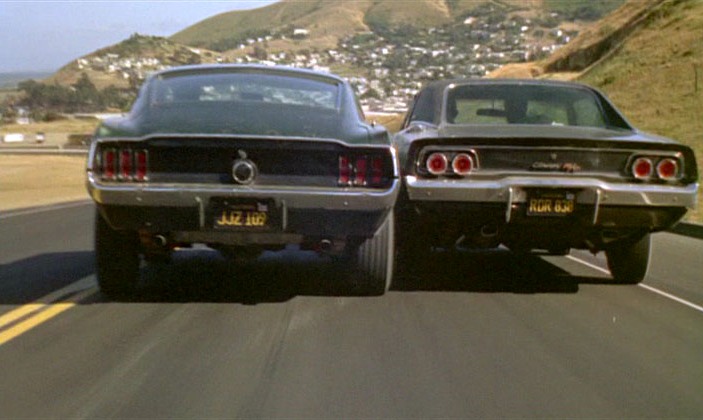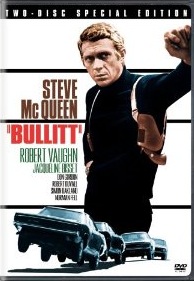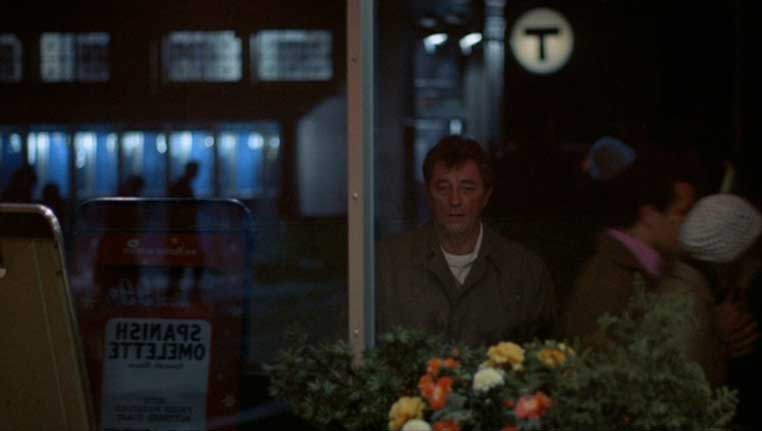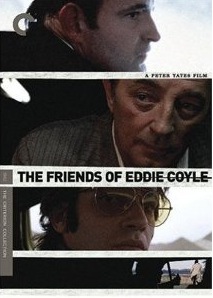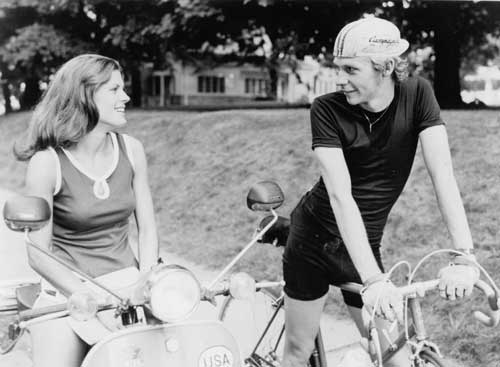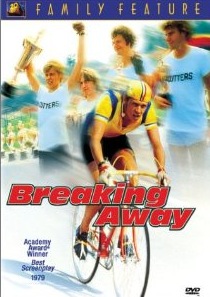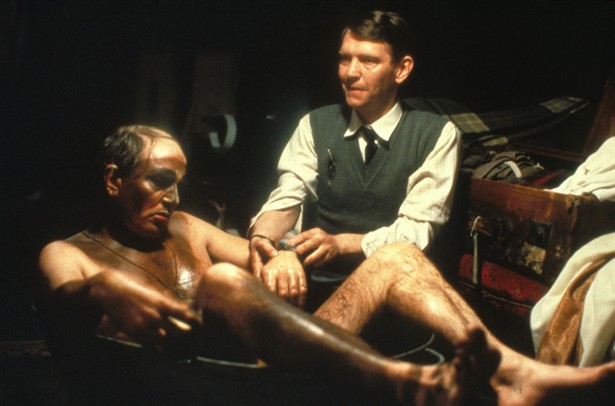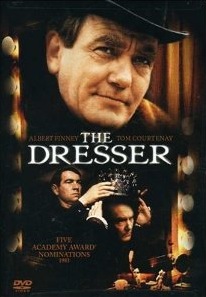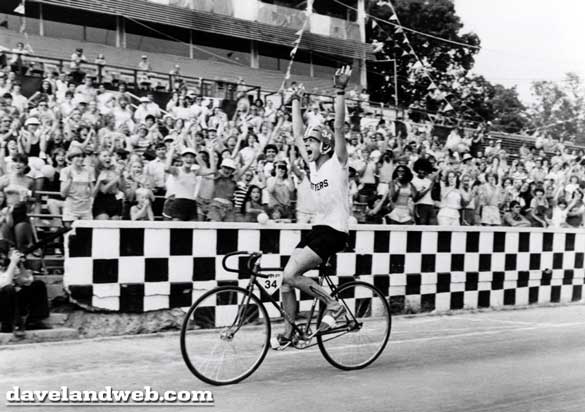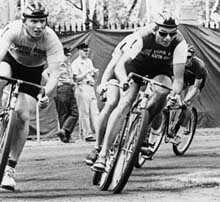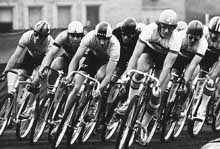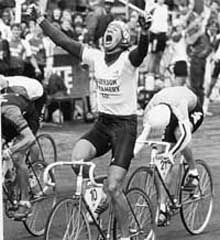Peter Yates: Big Thrills, Big Heart
July 24, 1929-January 9, 2011
By David McGee
There was much more to British film director Peter Yates than met the astonished eye in arguably the greatest car chase scene in film history, in his second movie, Bullitt (1968), starring Steve McQueen, who steered his 1968 Mustang GT up, down and around the vertiginous hills of San Francisco, sometimes going airborne, while chasing and being chased by a couple of ne’er-do-wells. The ten-minute sequence had audiences gripping their theater seats with white knuckle intensity and holding their collective breath as Yates’s elaborate ballet on wheels played out. The director had done this before, a year earlier, in fact, in his directorial debut in Robbery, a British film based on the Great Train Robbery. An impressive sequence, that, but nowhere near as gripping and thrilling as the one Yates choreographed a year later in the City by the Bay.
Peter Yates died in London on January 9 following a long illness. He was 81.
After breaking into the British theater as an actor, director and stage manager, Yates began helming TV episodes of The Saint before making his feature debut with the 1963 musical Summer Holiday, a bit of pop froth designed to showcase England’s reigning pop band, Cliff Richard and the Shadows, who were fast being eclipsed by the Beatles. 1967’s The Robbery served notice of his skill and artistry at action films, which led him the next year to Hollywood and Bullitt.
Academy recognition came later in Yates's career with the 1979 coming-of-age tale Breaking Away (he is less remembered for his 1977 terror-at-sea tale The Deep, based on a novel by Peter “Jaws” Benchley and starring Jaqueline Bissett, who is, however, remembered for wearing a wet t-shirt in the movie). Breaking Away, a poignant, class conscious comedy about four working-class teens who take on privileged students from the local university in a cycle race, was nominated for five Oscars, including best director and best film and won one for its screenplay by Steve Tesich. Four years later Yates's movie The Dresser, an adaptation of the Ronald Harwood play about an ageing actor's personal assistant, received five nominations, including, once again, best director and best film.
Following Bullitt’s success, Yates shot the poorly received 1969 romantic drama John and Mary, starring Dustin Hoffman and Mia Farrow. He returned to more action-oriented fare with 1971's Murphy's War, starring Peter O'Toole as a vengeful Irish merchant sailor who decides to singlehandedly take out the crew of the German U-boat who killed his shipmates.
His other films included The Hot Rock (1972), For Pete's Sake (1974), Eyewitness (1981), Krull (1983), Eleni (1985), Suspect (1987), The House on Carroll Street (1988), An Innocent Man (1989), Year of the Comet (1992), Roommates (1995) and Curtain Call (1999).
Writing in The Telegraph on February 8, David Gritten, while acknowledging the overpowering reputation of Bullitt as likely defining Yates in the public’s mind, cites both Breaking Away and The Dresser as closer to revealing the heart at the core of the director’s sensibilities and style. He reserves special praise, too, for 1973’s The Friends of Eddie Coyle, saying these three films proved Yates’s skill with actors.
Notes Gritten:
The Friends of Eddie Coyle starred Robert Mitchum, one of my very favorite screen actors, as a small-time gangster and police informant. Mitchum’s pretty good in it, and by 1973, almost no other director could elicit a decent performance out of Mitchum.I first met Yates, a hospitable, affable man, on the set of The Year of the Comet (1992). A genial romantic comedy caper, it fizzled at the box office. As the 20th century came to a close, it became increasingly tough for Yates to find work as a feature film director.
He switched to directing TV mini-series, as did his contemporaries John Frankenheimer, William Friedkin and Paul Mazursky. In 2000, Yates agreed to direct a TV adaptation of Don Quixote for TNT. (Not an easy story to film—just ask Terry Gilliam.) He did a creditable job, with John Lithgow as his Quixote and Bob Hoskins as Sancho Panza. But after another TV movie in 2004, Yates’s directing career ended.
In his 40-year career (it began with the Cliff Richard musical Summer Holiday), he steadfastly refused to tie himself down to a particular genre. Between career highlights, he made films as varied as Murphy’s War (1971), The Deep (1977), Eleni (1985) and The House on Carroll Street (1988). As Yates once told me, this genre-hopping was deliberate.
“After Bullitt, I was determined not to do another action film,” he recalled. “That may have been a mistake, but my theory was, perhaps selfishly, it’s much more interesting to be involved with different kinds of genres. If you’re just one kind of director, people will get tired of you. But if you make different films all the time, hopefully you’ll be judged on talent.”Because he perceived that the range of available Hollywood studio films was narrowing, and because he had no interest in teenage comedies or special effects movies, Yates left Los Angeles some 12 years ago and returned to his native England, where he was based when he made his last two mini-series for TV. He might have made a bigger name for himself had he stuck to action-thrillers, but his work was marked by a grace and expertise that never spilled over into flashy self-regard.
***
The Essential Peter Yates Films
A guide to some terrific Peter Yates films worth owning or paying cold hard cash to see on the big screen (which could be in your home or in a theater, y’know).
BULLITT (1968)
‘McQueen is great in Bullitt, and the movie is great, because director Peter Yates understands the McQueen image and works within it.’
by Roger Ebert
December 23, 1968
http://rogerebert.suntimes.com/apps/pbcs.dll/article?AID=/19681223/REVIEWS/812230301/1023Steve McQueen is sometimes criticized for only playing "himself" in the movies. This misses the boat, I think. Stars like McQueen, Bogart, Wayne or Newman aren't primarily actors, but presences. They have a myth, a personal legend they've built up in our minds during many movies, and when they try to play against that image it usually looks phony.
McQueen was a bomb as Thomas Crown, for example, because the character clashed with McQueen's own personality. But McQueen is great in Bullitt, and the movie is great, because director Peter Yates understands the McQueen image and works within it. He winds up with about the best action movie of recent years. McQueen plays a San Francisco cop assigned as bodyguard to a syndicate witness. The witness gets shotgunned—in the most brutally direct 10 seconds of film I can remember—and McQueen becomes a political football. Robert Vaughn (better than usual) is the politician who puts the heat on, and it's up to McQueen to hide the victim's body until he can untangle the case.
It's a very tangled case, too. The beautiful thing is that Yates and his writers keen everything straight. There's nothing worse than a complicated plot that loses track of itself (as in The Lady in Cement, which I defy anyone to explain).
Bullitt is Yates second film; his first was Robbery, a superior movie about England's great train robbery. Robbery had a great chase sequence in it, involving a running machine gun battle, all sorts of near misses in heavy traffic, lots of blood and remarkable photography. Bullitt, as everybody has heard by now, also includes a brilliant chase scene. McQueen (doing his own driving) is chased by, and chases, a couple of gangsters up and down San Francisco's hills. They slam into intersections, bounce halfway down the next hill, scrape by half a dozen near-misses, sideswipe each other, and leave your stomach somewhere in the basement for about 11 minutes.
One trouble. They couldn't be satisfied with a cop movie, I guess; they had to have sex appeal, and so they brought in Jacqueline Bisset (a lovely sight, true) to be McQueen's girl. And every line she recites is disastrously inappropriate. She has one speech so awful it takes the movie five minutes to recover.
Yates pulled the same trick in Robbery, giving Stanley Baker a wife he didn't need so the movie could have three unnecessary scenes with her. And Lee Remick cluttered up The Detective. And Inga Stevens was extra baggage in Madigan. They ought to leave the girls out or make them policewomen, like Coogan's Bluff did, come to think of it.
The two-disc Special Edition of Bullitt is available at www.amazon.com
The chase scene in Robbery (1967), a film based on the Great Train Robbery that marked the directorial debut of Peter Yates. Behold, the roots of the white-knuckle Bullitt chase scene.
And the classic in its entirety: The Bullitt car chase scene through the streets of San Francisco (1968)***
THE FRIENDS OF EDDIE COYLE (1973)
‘Strong, Simple Silences’
By Glenn Kenny
May 06, 2009
Posted at: http://somecamerunning.typepad.com/some_came_running/2011/01/the-friends-of-peter-yates.html"Young film fans raised in the multiplex era might look back and lament the fact that no one is making movies like The Friends of Eddie Coyle anymore," Kent Jones writes in his exemplary (as usual) essay on the 1973 film, included in the new Criterion DVD of it. "The truth is that they never did. There's only this one."
Robert Mitchum's performance as Eddie, the hangdog, hard-luck crook whose quiet desperation—in this story, he's due to start serving some time in a couple of weeks, and he's just not going to be able to hack it—compels his every move, is a huge part of the film's uniqueness. He underplays like nobody's business, and never announces himself. Not only does the trademark Mitchum smirk never once cross his face—looking at his work here, you'd never believe he had it in the first place. The rest of the superb cast seems to follow his lead. Alex Rocco, all piss and bluster as Moe Greene in The Godfather, isn't even particularly sinister here as the mastermind of a bankrobbing gang for whom Coyle is the arms supplier. Peter Boyle, as an innkeeper, informant, and eventually something more, is practically bland. The sole hopped-up performance is by Steven Keats as Jackie Brown, Coyle's supplier, a rookie who's got every reason to be nervous.
The Friends of Eddie Coyle, with Robert Mitchum as EddieVery little about these guys says "gangster" in the usual sense, just as very little about Richard Jordan's here T-man says "cop." Because everyone involved in the picture—the aforementioned cast, screenwriter Paul Monash, director Peter Yates (who applied a not-dissimilar sense of understatement to Bullitt several years before)—has an acute awareness that they're inhabiting the world of George V. Higgins, the attorney-turned-author who wrote the very fine novel on which this picture is based. (The only participant in the film who's not, alas, in this groove with everyone else is composer Dave Grusin, whose overstated "jazz" score is the sort of thing that gave the electric piano a bad name back in the day.) In Higgins' world, "the life" is normal life, and he renders its talk, and every other quotidian detail of it, with brisk, unforced accuracy. (Higgins' cachet among other genre writers and the filmmakers who love them is such that, yes, Elmore Leonard buff Quentin Tarantino did lift the above-cited character name Jackie Brown for his adaptation of Elmore Leonard's Rum Punch.) The dialogue is colorful, but not too colorful, and it tells a good deal of the story. But what's even more important to Higgins' storytelling, particularly in the very tight early works that made his reputation (the Boston-based author went on to attempt more sprawling works on politics and corruption, with mixed results—A Choice of Enemies is possibly the best of these, and a hell of a read it is) are the silences that fall between the spoken sentences. It's in these interstices when all of the decisions of the various characters are made: Am I gonna give this guy a break? Am I gonna keep my word? Am I gonna drop dime on him? Am I just gonna drop him?
The movie is suffused with just these silences. And Yates, working with cinematographer Victor J. Kemper, shows a similar sensitivity to physical space, as in the screen cap below. In a highly nondescript, not to say bleak, office, Jordan's cop Foley discusses Coyle and his case with his superior Waters (Mitchell Ryan, who comes off nothing like Mitchell Ryan here). Jordan is of course wonderful, and the dynamic between the two characters absorbing; but part of me watching was inexplicably drawn to that scrawny, lonely wire hanger on a hook on the wall, between them.
It's a simple detail that speaks volumes about this wintry, soul-sick world of Higgins'.
Trailer for The Friends of Eddie CoyleFunnily enough, the only place where the film deviates from Higgins' dialogue is at the very end, when Boyle's character talks about a guy he read about in the newspaper who's trying to develop a drug to eliminate pigeons from the world. It's not a bad piece of writing, but it sticks out like a sore thumb—it's the only time in the film that any of its characters speak metaphorically! I suppose you can't blame Monash for wanting to contribute something besides the excellent job of compression he did with Higgins' meticulously charted, inexorable plot.
The Criterion DVD of the picture is excellent (no, duh) and features, aside from Kent's essay, a largely engaging commentary by Yates, who's now in his late seventies, and a reprint of a very thorough 1973 Rolling Stone profile of Mitchum, which incorporates a visit to the set of Coyle.
The Friends of Eddie Coyle, Special Edition, is available at www.amazon.com
***
Breaking Away
‘His finest moment, human and true and timeless’
By David McGee
Despite its pronounced sub-plot of the conflict between the privileged students of Indiana University in Bloomington, IN, and the children of working class families—called “cutters” because stone cutting at the local limestone quarry was a major source of employment in Bloomington—Peter Yates’s Breaking Away is a tale for romantics of all ages, suffused with aching Italian arias, loving shots of the Indiana countryside and the heartwarming affection that develops between Dave Stoller, a cutter’s son played with a beautiful flair for the absurd by Dennis Christopher, and a high-class university student, Katherine Bennett, portrayed with nuanced empathy by Robyn Douglas. Young Stoller’s passion is bicycling, and he dreams of being able to compete with the elite Italian team—he is so deep into his dream, in fact, that he has adopted an Italian accent and whiles away his non-racing hours absorbing Italian operas. His mother, Evelyn Stoller (Barbara Barrie, in an Academy Award nominated performance) is in benign acceptance of her son’s eccentricities, rather enjoying his transformation, in fact, whereas father Ray Stoller (Paul Dooley, never funnier), is positively apoplectic, certain that he’s raising “an Italian bum.” Ray attempts to set his son on a more productive path by hiring him to work at his used car lot, only to have a near-nervous breakdown when Dave suggests some customers returning a lemon of a car deserve a refund.
Katherine Bennett (Robyn Douglass) and Dave Stoller (Dennis Christopher) on campus in Breaking AwayDave is not quite so aimless as the other high school graduates he hangs with: jock-ish Mike (Dennis Quaid, all washboard abs), sensibly goofy Cyril (a gawky Daniel Stern), and the high-strung, diminutive Moocher (a coiled Jackie Earle Haley). None, however, really have a clue what the future holds and no particular place to be other than where they’re at. In their own stumbling, bumbling way, though, the four friends have an endearing decency—screenwriter Steve Tesich, who experienced a Breaking Away-like moment of his own while a student at Indian U., understands these characters and draws them broadly and sympathetically, as if acknowledging that circumstances sometimes dictate it taking longer for some to find their way than others.
‘His name is Jake, not Fellini.’ Paul Dooley and Barbara Barrie in Breaking AwayIn the meantime, Dave, in full Italian splendor, meets and falls in love with Katherine—“Katarina,” he calls her—who buys his line of being an exchange student named Enrico Gismondi. Intrigued by Enrico’s romantic nature, she slowly warms to him, even though she’s dating a Big Man On Campus, the smug Rob, who, like his friends, has no use for cutters and is outwardly hostile to them to boot (playing Rob, Hart Bochner gives a pitch-perfect, oleaginous performance as a snooty, privileged Indiana U. frat boy jock whose smug sense of entitlement had moviegoers in theaters across the land rooting hard against him from the moment he first appeared on screen),
The scales fall from Dave’s eyes when his beloved Italians come to Bloomington to race. Dave is good enough to be able to keep up with them, but they will have none of it: one of the racers upends Dave’s bike by jamming one of his wheels with an air pump, causing Dave to tumble headlong into a ditch, his dream shattered for good. In the wake of this cataclysmic event, Dave shelves his Enrico guise, fesses up to Katherine—breaking her heart—and ponders his bleak future.
‘Refund! Refund!’Only when Dave’s cutter friends talk him into leading their team in the annual “Little 500” bicycle race does he find purpose again. Being the only trained rider, by design he plans to carry the load. When he suffers an injury during the race, his teammates step up and take their laps, staying within shooting distance of the frat boys while Dave regroups. On the oval track of the Little 500, Peter Yates’s skill at directing action sequences makes for an exhilarating denouement. Yes, Dave kicks it up a notch on the final laps and the cutters win, even drawing grudging applause from the frat boys for their triumph.
No sooner has Ray Stoller become accustomed to having his son back than does young Dave meet an enticing, demure French lass on campus. In the memorable final scene, Dave, on his bike, encounters his dad squiring a potential customer around town and bids him, “Bonjour, papa!” as the camera freezes on Ray’s astonished, bug-eyed mien.
Daniel Stern on the staying power of Breaking AwayIn true Yates fashion, and in a testament to the integrity of Tesich’s script, Dave Stoller and his friends are not magically transformed into superheroes—their triumph is one of hard work and determination, of using what wits and muscle they have and refusing to give in or give up. The cutters have no special gifts, divine intervention is not at hand, eating a can of spinach is not going to produce powers beyond any the young men had displayed earlier. A year after Bruce Springsteen sang “Badlands, you gotta live it every day/let the broken hearts stand as the price you gotta pay/we’ll keep pushin’ till it’s understood/and these badlands start treating us good,” the cutters speeding around the course of the Little 500, but competing in something much larger than a bicycle race, perfectly embodied the ethos articulated in the first song on Darkness On the Edge of Town, an album in which Springsteen dug deep into the quest for purpose and meaning in life. Breaking Away is Peter Yates’s finest moment, human and true and timeless. -–David McGee
Breaking Away won Best Screenplay (by Steve Tesich) at the 1979 Academy Awards. It was also nominated for Best Picture, Barbara Barrie was nominated for Best Supporting Actress, Peter Yates was nominated for Best Director, and the movie was nominated for Best Adaptation Score (use of non-original music).
Breaking Away is available at www.amazon.comEverything you wanted to know about Breaking Away is online at Diablo Scott’s Bike Blog in the August 1, 2000 posting, “My Breaking Away Tribute Page”
***
THE DRESSER (1983)
‘Life in the theater with a capital T’
It's life in the Theater with a capital T in this film adaptation of the London and Broadway hit by Ronald Harwood. Though we see other people, the film is really a duet between Sir (Albert Finney), an aging actor-manager who runs his own theater company, and Norman (Tom Courtenay), his dresser, who gets him into costume and, ultimately, into shape to go onstage each night. Sir is on his last legs; Norman is alternately his cheerleader, his parent, and his whipping boy—whatever it takes to get Sir up to performance level each night. Finney perfectly captures the vainglorious insecurity of this aging ham, whose career has never quite matched his expectations but who has to convince himself each night (with Norman's help) that a performance in the provinces is as big a deal as treading the boards in the West End. The film lives and dies, however, with Courtenay's neatly nuanced performance as Norman. No man is a hero to his valet—but Courtenay finds the affection along with the disdain that are part of this character. A great backstage tale. —Marshall Fine @ amazon.com
Five Academy Award nominations 1983: Best Picture, Best Actor, Best Supporting Actor, Best Director, Best Screenplay Adaptation.
Trailer for The Dresser (1983)
The Dresser is available at www.amazon.com
The Real Breaking Away
Dave Stoller was no mere fiction, and once upon a time a Cutters team really did beat the Greeks to win the Indiana University Little 500 race
In Peter Yates's film Breaking Away, the penultimate scene takes place at Indiana University's annual Little 500 bicycle race, an event that dated back to May 12, 1951. The first superstar, if you will, to emerge from the Little 500 appeared a decade later in the person of Dave Blase, a native of Speedway, Indiana, described in the IU Alumni magazine as "quiet and reclusive," who first rode for his dormitory team but in 1960 joined Phi Kappa Psi, the reigning Little 500 champions. His defection from the dorms spurred the IU administration to enact a rule prohibiting dorm-to-frat transfers for riding in the Little 500 in their first frat year. When Phi Psi won its third straight race in 1960, IU, concerned about one team's dominance, took a harder look at Blase and again declared him ineligible to race, owing to Blase's active competitive bicycling activities (he won the 1959 Midwest Championships and participated in Olympic and Pan-American Games trials), which the University declared gave him too much of an advantage over his student competitors.
"I was the only one they were aiming at," Blase said, "and everybody on campus knew it."
After rules kept him out of the race
for two years, Dave Blase, wearing
sunglasses, pedaled to victory for
Phi Kappa Psi in 1962. At the time
his 139 laps were the most ever for
one rider on a winning team.
Photo IU ArchivesFed up with being targeted by IU, Blase left school after the fall 1960 semester and returned home. On his own he continued to train. During this sabbatical he also met some Italian doctors, whose style and language entranced him to the point where he took their mannerisms for his own and began speaking with an Italian accent. He also began studying and emulating the top European racers of his time. When IU revoked the "Dave Blase Rule," Blase returned to the University, competed in and dominated the 1962 Little 500, clocking a then-record 139 of the race’s 200 laps. A star among his frat mates, Blase also had his share of female devotees, although the IU Alumni Magazine reports "the real Blase never could approach them." One of Blase's Phi Psi teammates and friends on the winning '62 team was Steve Tesich, who later immortalized Blase as Dave Stoller in his Academy Award winning screenplay Breaking Away. Blase had two roles in the film as well: he was the Little 500 announcer, and he rode in the Cinzano 100 race, wearing a TI Raleigh jersey. He was the last rider Dave Stoller passed on his way to meet up with the Italian racers he so admires and who promptly conspire to crash his bike. The name Dave Stoller is a combination of Dave Blase, and Bob Stohler who was the team's director in 1962. Blase became a high school biology teacher and Stohler had a position with the IU school of business. —David McGee
Dave Blase remembers the glory days
***
Rise Of The Cutters
Throughout its first 20 years, the Little 500 could always be counted on for end-of-the-year fun and camaraderie, but for some housing units it took on a much greater role— lifesaver. In the highly competitive fraternity circles, the battle to excel in sports, social scenes, and new-member recruiting was never-ending. But some fraternities found that with a top bike team, many of those battles could be won in one weekend.
Delta Chi recruited Illinois cycling
champion Eddy Van Guyse, riding
in 1972 with four stars on his helmet,
to help establish its racing dynasty.
Photo Martha Lea ArmstrongIn 1968, Delta Chi President Steve Reisinger, BS'70, MBA'74, knew the time had come for an upheaval in his house. The fraternity was believed to be one of the smallest on campus in terms of membership, and it did not do especially well academically, socially, or athletically. In recent years it had lagged behind other fraternities in the Little 500 as well. Rebuilding—essentially on two wheels—could be the way to keep Delta Chi afloat.
The road to rebuilding began with the recruiting of Eddy Van Guyse, BA'72, an Illinois state cycling champion who was also making noise on the national level. Reisinger talked Van Guyse out of attending the University of Illinois, making the final sale by taking the Belgian native to the 1968 Little 500 qualifications.
"I was in awe to see a campus where bicycle riders were heroes," Van Guyse recalls. It would not be long until he too would become a hero. During his 1969-72 Little 500 career, he never won a race but earned the respect of other riders and, later, induction into the event's Hall of Fame.
For Delta Chi, his presence marked the beginning of a dynasty that attracted an unprecedented number of powerhouse riders. The team won its first race one year after Van Guyse left, in 1973. Wayne Stetina, BA'78, a member of the 1972 U.S. Olympic Team, anchored that incredible group. The win would be the first of seven in a nine-year span - the most prolific streak the Little 500 has ever seen.
The fraternity waged regular battles with IUSF over eligibility rules—it won even in years where a rider would be ruled ineligible—and occasionally with other teams over perceived inequities in everything from Delta Chi's training methods to their bicycles. Nothing unusual ever came to light, however, except for the fact that from 1973 to 1981 one fraternity was nearly invincible.
Despite its success in conquering the Little 500, Delta Chi's internal strength never quite reached the level of IU's top fraternities. For one weekend each year, the bike team stood front and center, but over the rest of the year Delta Chi was plagued by financial woes and insufficient members to fill its North Jordan house.
A group of local alumni tried to turn the house's fortunes around in 1983. To get rid of the perception that Delta Chi lived only for the Little 500, the alumni board did not renew the housing contracts of dedicated riders Adam Giles, BS'85, MBA'92, and Scott Senese, BS'85, forcing them off campus. Riders Adam Beck, BA'84, and Randy Strong, BS'84, felt stronger ties to their teammates than to their house and left as well.
Many key figures from the dynasty years sided with the riders in the bitter conflict. They suggested that for the 1984 race the now independent team borrow a name from "Breaking Away" that signified its situation. The real-life Cutters were born.
In 1984 former Delta Chi Adam Giles
crosses the finish line to capture
victory for the upstart Cutters.
Photo IU Student Foundation.History was very much against the Cutters on April 22, 1984. No team not affiliated with a dormitory or Greek house had ever won a Little 500, and not since the 1955 South Cottage Grove team had a group won the race on its first try. But with a household name on their backs and a maverick-like mystique that appealed to many unaffiliated race fans, the Cutters were far and away the sentimental favorites.
"There was almost a grass-roots groundswell of support," Giles recalls. And sure enough, the Cutters delivered, with Giles taking the checkered flag after a sprint finish that very much mirrored the fictitious finish of the movie.
For one year the Cutters were a Cinderella story come true. Over time they proved to be more than just a one-year Little 500 anomaly. Through 1994 the team won three more times ('86, '88, '92) and finished no lower than fifth in all other races. As a successful independent unit, the Cutters changed the face of Little 500 cycling, attracting top talent and frustrating the Greek cycling community, which collectively was unaccustomed to having to settle for second place.
There was even a successful spin-off. In 1989 another Breaking Away-inspired team, Cinzano, won just ahead of the Cutters—a fitting end to a Little 500 season that had been celebrating the 10th anniversary of Bloomington's favorite movie.
(Ed. Note: Since this article was written, the Cutters have won a total of 10 Little 500 titles, including three straight between 2007-2009.)
(Portions of this account were drawn from "Pedaling Through 50 Years of Little 500 History" by John Schwarb, published in the Indiana University Alumni Magazine. Schwarb is the author of The Little 500: The World's Greatest College Weekend [Indiana University Press, 1999]).
THE BLUEGRASS SPECIAL
Founder/Publisher/Editor: David McGee
Contributing Editors: Billy Altman, Laura Fissinger, Christopher Hill, Derk Richardson
Logo Design: John Mendelsohn (www.johnmendelsohn.com)
Website Design: Kieran McGee (www.kieranmcgee.com)
Staff Photographers: Audrey Harrod (Louisville, KY; www.flickr.com/audreyharrod), Alicia Zappier (New York)
E-mail: thebluegrassspecial@gmail.com
Mailing Address: David McGee, 201 W. 85 St.—5B, New York, NY 10024
Founder/Publisher/Editor: David McGee
Contributing Editors: Billy Altman, Laura Fissinger, Christopher Hill, Derk Richardson
Logo Design: John Mendelsohn (www.johnmendelsohn.com)
Website Design: Kieran McGee (www.kieranmcgee.com)
Staff Photographers: Audrey Harrod (Louisville, KY; www.flickr.com/audreyharrod), Alicia Zappier (New York)
E-mail: thebluegrassspecial@gmail.com
Mailing Address: David McGee, 201 W. 85 St.—5B, New York, NY 10024



